Gladstone Gardens
The club at 1605-07 Nicollet Ave. went through several iterations as music venues. This page tells the entertainment history of the building as the:
- Gladstone Garden
- Original Flame Theatre Lounge (not to be confused with the Flame Cafe)
- Hoop-D-Doo
THE LORING BUILDING
According to one account the building was built in 1915, although permit cards seem clear that an original building was moved to this spot from 105 Ninth Street So. in 1890, and that construction began on a brick store and office building in 1921/22. It was a two-story building – originally the second floor had a mix of apartments and an occasional business, and later just offices on the second floor. When the building was demolished, its footprint was 142′ by 68′.
This venue is a bit hard to pin down, as there are two adjacent addresses, and they start out separate, but are advertised by both addresses later on. They were probably joined in 1941.
1607 NICOLLET
This space was apparently very large, with a stage, rehearsal hall, Opera Hall, dressing rooms, etc.
From December 1921 to August 1922, it was the Opera Hall of the Edwin Skedden American School of Opera.
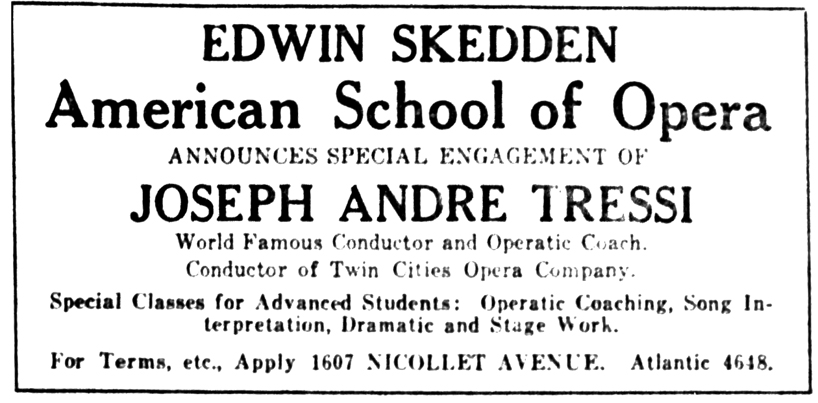
Minneapolis Tribune, April 9, 1922
In September 1922, it was leased to the McPhail School of Music and Dramatic Art. This apparently lasted until August 1923.
September 10, 1923: Caserta School of Dancing took over the space.
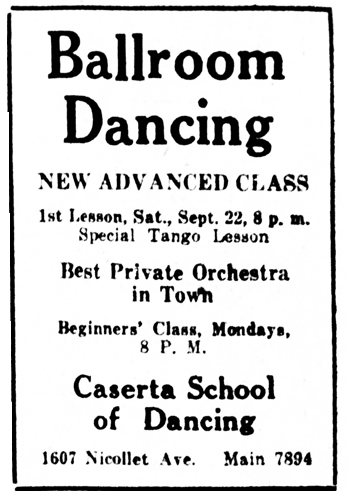
Minneapolis Tribune, September 21, 1923
September 1924: Howe School of Music
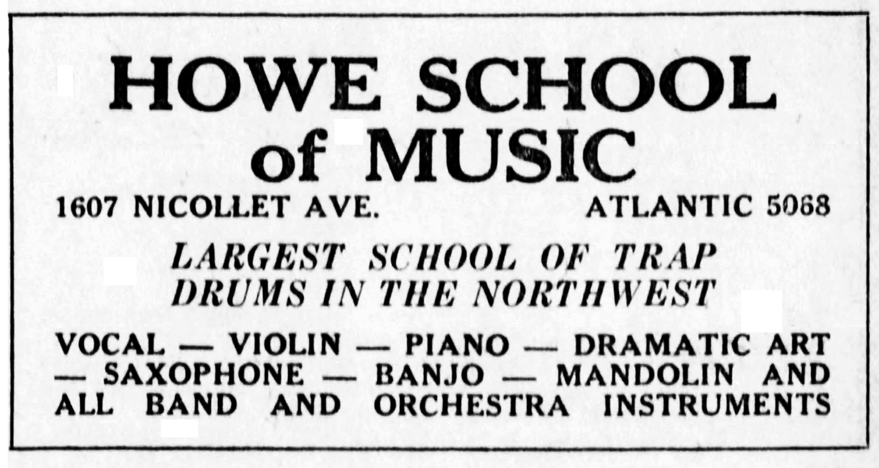
Minneapolis Star, August 29, 1925
In December 1932, 1607 Nicollet was the address of a tabloid newspaper called the Brevities, then embroiled in an extortion plot.
In January 1940, it was Gould Music Studios.
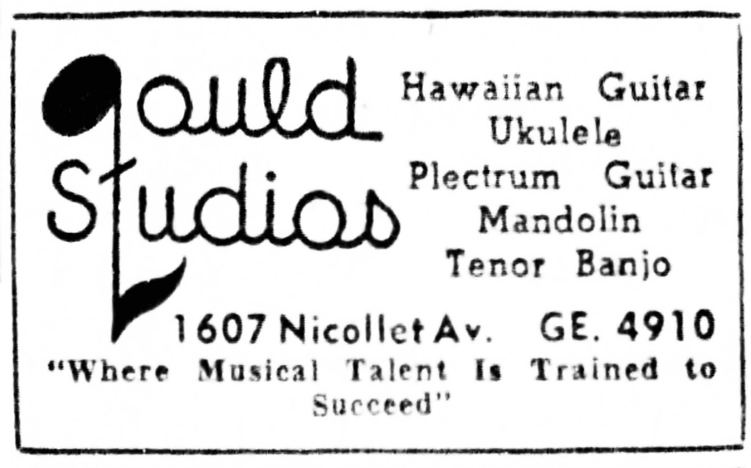
Minneapolis Tribune, March 17, 1940
WEIRDNESS IN THE HALL
An adjunct of the hall with the same address was the home of several sequential organizations with names like the Unity Society of Right Thinking and several psychic societies. In November 1951 there was an ad for something called the “Metaphysical Truth Center,” led by Reverend Prince Yogi. Alas, Yogi was unmasked as one Lawrence Day, a convicted bootlegger. The city attorney told the jury that “A fortune teller or like imposter is a vagrant under the law.” With tongue in cheek the Star reported that “The jury retired then and settled Day’s future” by sending him to the workhouse for 90 days.
1605 NICOLLET
GLADSTONE GARDEN
In January 1923 to January 1, 1930, Gladstone Lunch was owned by Thomas V. Pappas; he later added a partner named Jack Keprios.
On January 1931 it was called Gladstone Garden Lunch.
By December 1932 it was simply Gladstone Garden – by all appearances just a restaurant, “open all night.”
In March 1934, at a hearing for application for a liquor license, a City Alderman pointed out that the Gladstone was “the oldest cafe on Nicollet Avenue.”
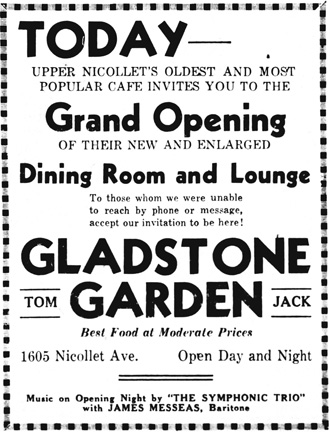
Minneapolis Star, December 5, 1935
$2,000 in alterations were made to the cafe at the end of 1938/beginning of 1939.
In August 1941, Tom Pappas wanted to transfer his liquor license to a building he wanted to build at 133 East Lake Street (at Stevens), which would be a tavern and bowling alley. The proposal was dropped after much community opposition. (The area is apparently under 35W now.) (Minneapolis Tribune, August 6, 1941)
In February 1942, 1605 Nicollet was altered at a cost of $2,300. At this point my assumption is that 1607 was added to 1605 to make a larger club.
In March 1942, Cedric Adams reported in his “In This Corner” column that Benny Harris had put $25,000 into the building and was intending to call it the Flame. “Harris, who in the old days had such spots as Boulevards of Paris and the Plantation, dickered recently for Harry’s Cafe.” (Minneapolis Star Journal, March 18, 1942)
FLAME THEATRE LOUNGE
The next use of the building was the Flame Theatre Lounge, from 1942 to 1951. Since there were so many Flames, let’s call this the 1607 Flame, since that’s the address that was the most frequently used.
It opened on April 10, 1942, with Manager Ben Harris. The Flame featured vaudeville, jazz, and other types of music. An unsigned and undated memo (probably from the mid-to-late 1940s) indicates that the deed was held by one Michael Crakes but that the quit claim deed could be held by local gangster Tommy Banks.
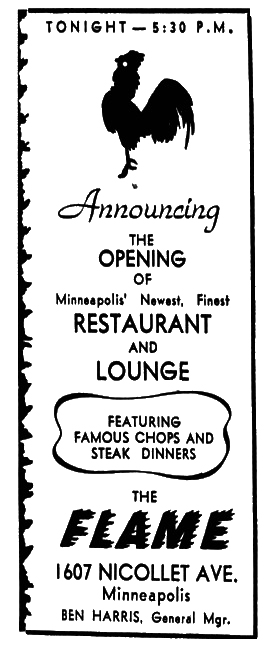
Minneapolis Star, April 10, 1942
Although it featured steaks and chops, a rooster seemed to be its mascot.
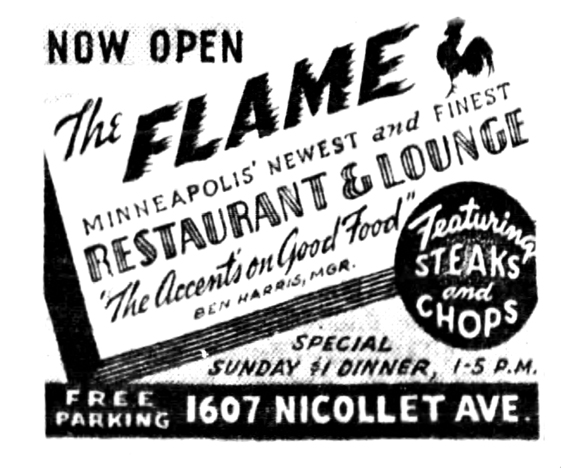
Minneapolis Star, May 15, 1942
On March 21, 1943, the Manager was Joey Swartz.
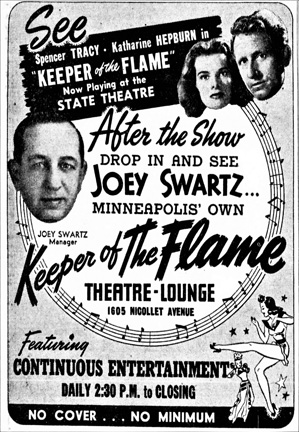
Minneapolis Star, March 26, 1943
In 1944, the place was advertised as the New Flame. These ads make it look like a fun place!
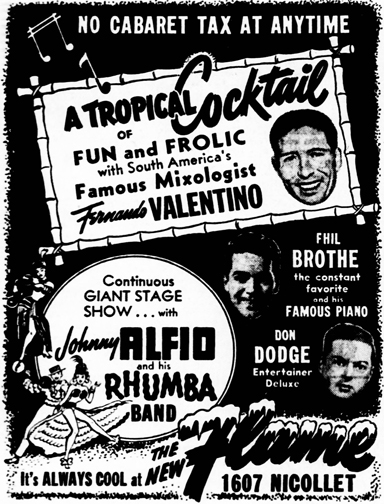
Minneapolis Tribune, July 2, 1944
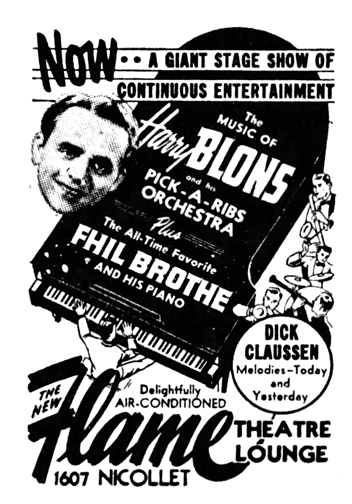
Minneapolis Star, July 12, 1945
Manager Joey Swartz was charged with attacking employee Elmer P. Fox on November 20, 1944, and Elmer tried to sue Joey’s wife Freda, the owner of the bar, for $8,500 in damages. Freda was covered by a worker’s compensation claim, but Elmer was awarded $1,000 from Joey, who was a former professional boxer and had taken out nine of Elmer’s teeth in the altercation. (Minneapolis Tribune, May 3, 1946)
The Flame went up in flames on July 21, 1947, but was quickly extinguished. It was confined to the rear lounge and damage was slight, although three windows were blown out.
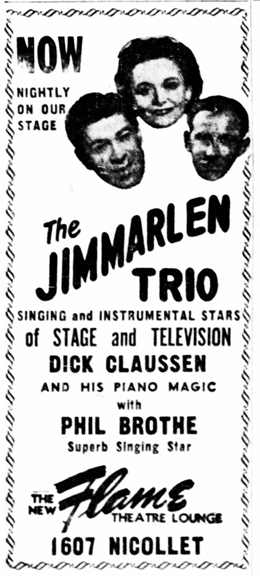
Minneapolis Tribune, July 30, 1950
TRANSFER OF THE FLAME
An article in the Trib dated January 18, 1951, indicated that Mrs. Freda Swartz operated the Flame at 1605 Nicollet, and requested the transfer of the Flame’s 3.2 beer license to the Club Carnival site at 1523 Nicollet, which was vacant at that time. Samuel Markowitz had been the assistant manager of the 1607 Flame, and planned to operate in 1607 Nicollet building. The old Club Carnival building would become the new Flame.
HOOP-D-DOO
After the Flame name was transferred, in about August 1951 the 1607 Nicollet club became a 3.2 beer tavern called the Hoop-D-Doo Bar and Cafe. The proprietor of the Hoop-D-Doo was Harry Ressen.
In 1951 there was a schedule of sorts at the Hoop-D-Doo:
- Wrestling matches on Tuesdays
- Amateur Shows on Thursdays
- Jam Sessions starting at 2 pm on Sundays. Stebbins: “This place quickly became a congregating point for jazz musicians both local and out of town, and it was not uncommon to have national stars sitting in with the [Bob Davis house] band.”
In August 1952 the tavern was raided by the morals squad, which yanked out six girls accused of being underage. (Minneapolis Tribune, August 8, 1952)
In August 1953 an irreverent account told of “Hoop-la at Hoop-de-doo,” in which two patrons mixed it up and Ressen tried to stop the fight and eject the aggressor. Instead, both fell through the plate glass window of the front door. Then, to make matters worse, the first patron came out and “bopped” the other guy as he lay on the sidewalk. Harry had cuts on his legs and thighs, and the other guy had a broken nose. (Minneapolis Star, August 8, 1953)
In 1954 the Hoop-D-Doo made news again when an alert waitress overheard a 6′ 6″ robber making a plane reservation to Detroit. They caught him at the airport. (Minneapolis Tribune, January 19, 1954)
CHAR-BURGERS
In May 1954, Cedric Adams commented on the merits of the tavern’s char-burger, perhaps the first in the Twin Cities. Soon afterwards, the place was called the Char-Burger AND the Hoop-D-Doo. (Minneapolis Tribune, May 30, 1954)
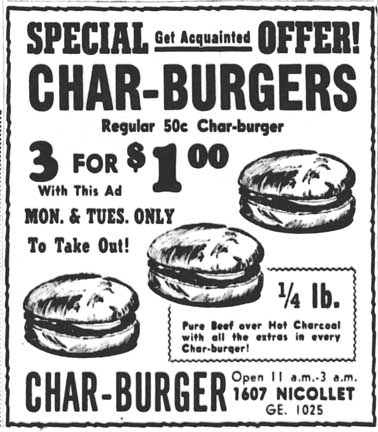
Minneapolis Star, October 16, 1954
In July 1954 the upstairs Valor Hotel was padlocked as a public nuisance for prostitution. Ressen had sold the hotel license and furniture to Frank E. Thew, and Thew was given 90 days in the workhouse for keeping a brothel. (Minneapolis Tribune, July 15, 1954)
Things were getting ugly – Chester LaRue got a glass bottle poked in his eye and risked losing it after he bumped into a guy holding a glass bottle. Let’s hope the docs at General Hospital were able to save Chester’s eye. (Minneapolis Star, October 23, 1954) The guy charged with wielding the bottle was acquitted. (Star, February 8, 1955)
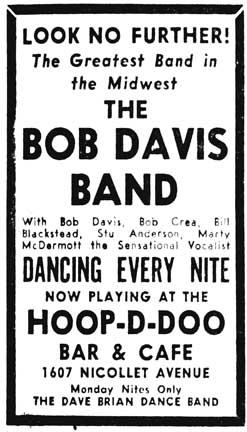
Minneapolis Tribune, November 26, 1954
In May 1955, Will Jones commented about the char-broiled food, but also that it was the only 3.2 joint with a strip teaser. This bears an extended quote:
The girl doesn’t work up on a stage to be gawked at from a distance. She does her work on the dance floor, at customer level, surrounded by customers. A beefy little number named Ginger is the current attraction. Bob Davis’ band supplies the music.
The non-paid dancers, or customers, are frequently as entertaining as the paid one. All this entertainment is available to any citizen with the price of a 20-cent tap beer, which price includes the cabaret tax. I don’t think bargain is too strong a word to use here.
But unfortunately for Miss Cathy Carson, the morals squad deemed her costume too skimpy and her dance too suggestive. All she had on when she was arrested was “a few beads in one place and a G-string and a small amount of fringe in another,” said Jake Sullivan, head of the morals squad. Miss Carson plead guilty and paid her $100 fine, but defended herself by saying that she had asked how far she could go when she first hit town, and was told “as far as I like.” Said Sullivan, “Someone misinformed her.” (Minneapolis Star, July 23, 1955)
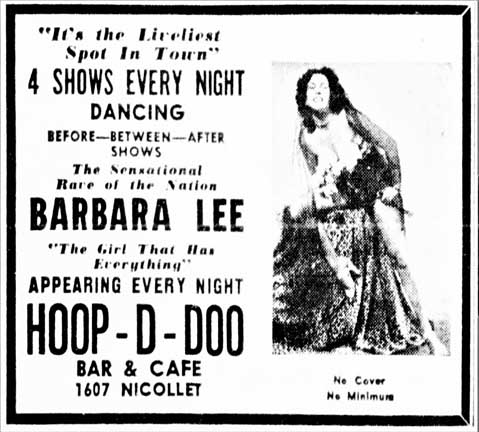
Minneapolis Tribune, October 22, 1955
In November 1955, building owner Leo Villas announced plans to totally remodel the building. After dentist A. Arnold Axilrod, who had had an office upstairs, was convicted of killing one Mary Moonen, perhaps it needed an exorcism. Renovations were reported to be in the area of $125,000 to $150,000. At the time, the second floor was occupied by professional offices. The main floor had 10,000 square feet, divided into eight retail stores. (Minneapolis Tribune, November 6, 1955)
Below is a photo of how it looked in about 1956. The Char-Grill and the Hoop-D-Doo are in the third section from the left, with the large protruding sign.
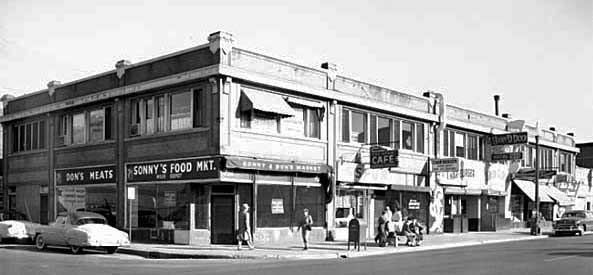
1956 photo courtesy Minnesota Historical Society
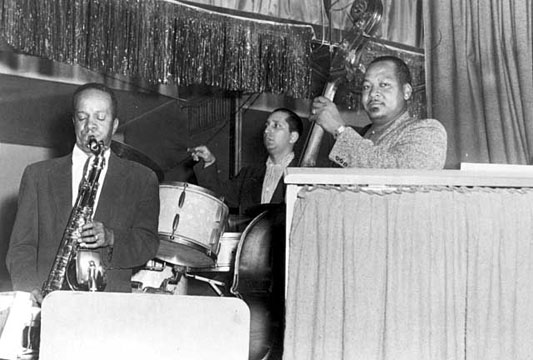
Hoop-D-Doo jazz session, September 1956, courtesy Ira Pettiford/Minnesota Historical Society
Mrs. Helene Ressen (was Harry dead by now?) was given a 30 day suspension of her licenses for selling beer to a minor. The original committee recommendation only called for a ten-day suspension. (Minneapolis Star, December 1, 1956)
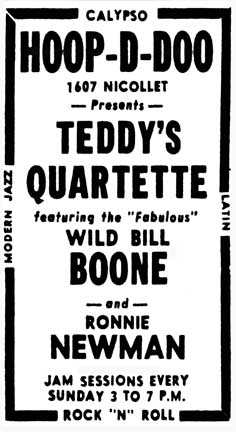
Minneapolis Star, March 14, 1957
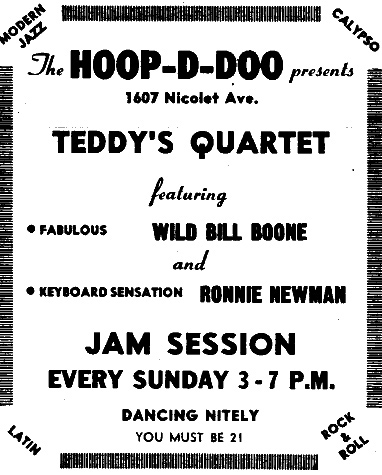
Undated Minnesota Daily ad, courtesy Robb Henry
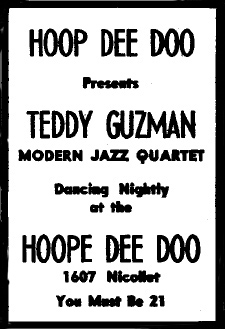
Undated Minnesota Daily ad, courtesy Robb Henry
FIRE ONE
On August 6, 1957, the “liveliest spot in town” became the “hottest as well” when a three-alarm fire hit the building, burning out eight business, including the Hoop-D-Doo. Caretakers Mr. and Mrs. Frank Molumby lived in an apartment in the building, and firefighters had to break down their door to rouse them. The fire was preliminarily found to have been started “in the back of the Hoop-D-Doo, in an arm of the tavern” that ran behind a vacant beauty shop. (Minneapolis Star, August 6, 1957) Permit cards show $18,000 in repairs and alterations.
KING’S LANES
After the fire, part of the building, including the part that had been the Hoop-D-Doo, was converted into a deluxe bowling alley. The building permit for that alteration was dated January 28, 1958, and the construction cost estimate was $15,000.
The bowling alley opened in about April of 1958. Amenities included:
- Six bowling alleys on the second floor
- Eight bowling alleys on the first floor
- A nursery with babysitters
- An entertainment room with TV and movies
- A billiard room with five billiard tables
- A restaurant that could seat 100 patrons
Why this Grand Opening ad below was placed in 1959 is unclear, unless bowling alleys were only open seasonally:
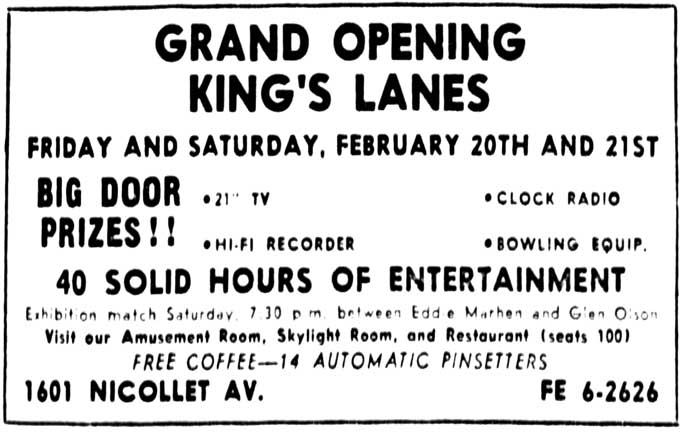
Minneapolis Tribune, February 19, 1959
FIRE TWO
Well, by now the building was truly cursed. On April 18, 1960, another three-alarm fire erupted on “the second floor in the back end of the bowling alleys and in a cockloft” – specifically in a storeroom with wooden pop cases and “a quantity of paper cartons of matches.” Smoke was extensive throughout. Owner Leo Villas lived on the second floor above the bowling alley and had to be treated at General Hospital for smoke inhalation – twice he tried to go back into the building before being restrained. Damage amounted to about $200,000. The building permit set the estimate of repairs at $10,000 plus wiring, plumbing, etc.
FIRE THREE
The bowling alley was relatively unscathed by the 1960 fire and was reopened. But disaster hit a third and final time on April 15, 1963 – this time a four-alarm fire that burned out of control for four hours. This time the roof collapsed, and the the first floor collapsed into the basement. The bowling alleys from both the first and second floors were found in the basement the next morning. Damage was estimated at $500,000.
Owner Villas finally gave up the ghost – the building was torn down in July 1963.
County tax records indicate that the site is now vacant; I-94 runs directly south.
